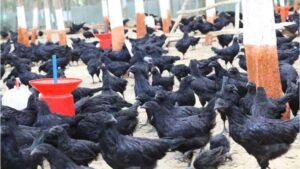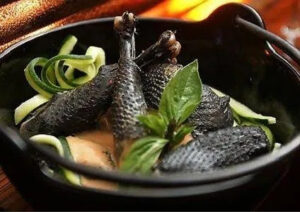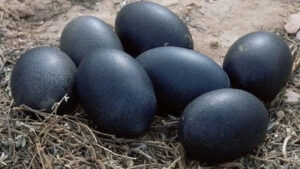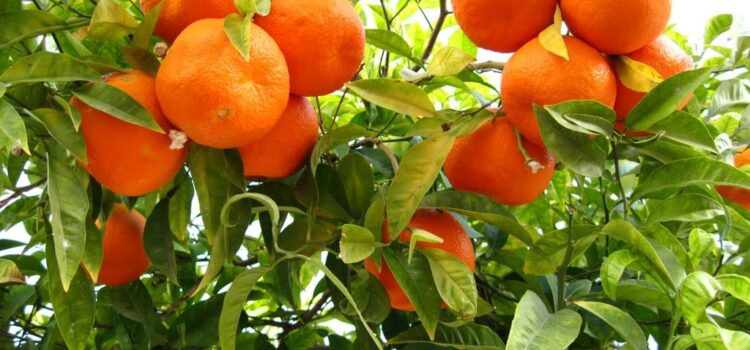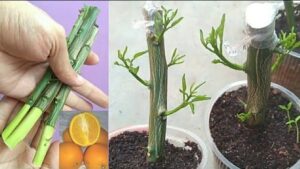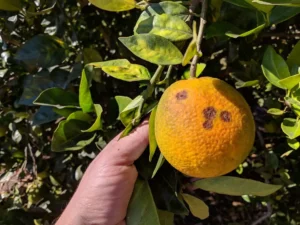Guava Cultivation: A Complete Guide
Guava (Psidium guajava) is a tropical fruit that is popular for its delicious taste, nutritional value, and health benefits. It can be grown in various regions with a tropical or subtropical climate. Here is some general information on guava cultivation. Guava cultivation is a thriving agricultural practice that involves growing the tropical fruit, guava (Psidium guajava), for its delectable taste, nutritional value, and versatility in culinary applications.
Native to Central America, guava is now widely cultivated in tropical and subtropical regions around the world due to its adaptability and ability to thrive in diverse climatic conditions. With its enticing aroma, sweet and tangy flavor, and abundant health benefits, guava has become a favorite fruit among consumers and a profitable crop for farmers.
Its high content of essential vitamins, minerals, and antioxidants makes it a valuable addition to a balanced diet. Guava trees are evergreen, moderately-sized, and feature smooth, green leaves that provide ample shade. The fruit, which can vary in size, shape, and color depending on the variety, typically has a green or yellow skin when ripe and a soft, juicy flesh filled with numerous small seeds.
Guava cultivation offers an opportunity for sustainable agriculture, as the plant requires relatively low water inputs and exhibits a robust resistance to various pests and diseases. Furthermore, guava fruits are used not only for fresh consumption but also for processing into juices, jams, jellies, and other value-added products, enhancing their economic value.
1. Climate and Soil Requirements:
Climate:
- Temperature: Guava prefers a warm climate with temperatures ranging from 25°C to 35°C (77°F to 95°F). It can tolerate brief periods of temperature drops to 10°C (50°F) but may suffer damage from frost or extended cold spells.
- Humidity: Guava grows well in areas with moderate to high humidity levels. However, it can tolerate dry conditions once established, but adequate irrigation is essential during dry spells.
- Rainfall: Guava requires a well-distributed annual rainfall ranging from 1000mm to 2000mm (40 inches to 80 inches). Heavy rainfall and waterlogging should be avoided during flowering and fruiting to prevent fruit drop and disease issues.
Soil:
- Soil Type: Guava can grow in a variety of soil types, but well-draining soils with good aeration are essential for successful cultivation. Sandy loam, loam, and clay loam soils are considered suitable. Avoid waterlogged and heavy clay soils, as they can lead to root rot and poor growth.
- pH Level: The ideal soil pH for guava cultivation is between 6.0 and 7.5. It can tolerate slightly acidic to slightly alkaline conditions, but extreme pH levels should be avoided.
- Soil Fertility: Guava thrives in fertile soils rich in organic matter. Adding organic compost or well-rotted manure to the soil before planting can improve fertility and overall plant health.
Altitude:
- Guava is generally grown at elevations ranging from sea level up to 1500 meters (4921 feet). However, it performs best in lowland areas and lower elevations where temperatures are warmer.
Sunlight:
- Guava is a sun-loving plant and requires full sunlight for optimal growth and fruit production. A minimum of 6-8 hours of direct sunlight per day is recommended.
Wind:
- While guava can tolerate moderate winds, it is best to provide some protection from strong, drying winds that can stress the plant and reduce fruit quality.
Water Requirements:
- Guava requires regular watering, especially during its establishment phase and the fruiting season. Adequate irrigation is crucial for proper fruit development and yield. However, waterlogged conditions should be avoided as they can lead to root rot.

2. Varieties:
There are many different varieties of guava available, with variations in taste, size, and color. Some popular varieties include Allahabad Safeda, Lucknow-49, Allahabad Surkha, Thai Maroon, and Red Malaysian. Some of the popular commercial varieties of guava include:
-
Red Malaysian (Red Flesh):
This variety is known for its striking red-pink flesh, sweet flavor, and pleasant aroma. The fruits are medium-sized and have a thin skin. Red Malaysian guava is popular for fresh consumption and is used in making juices and desserts.
-
White Malaysian (White Flesh):
This variety has white or pale yellow flesh with a mild, sweet flavor. The skin is greenish-yellow and thin. White Malaysian guava is also favored for fresh consumption and juice production.
Ruby X is a popular guava variety known for its large size, sweet taste, and reddish-pink flesh. It is a hybrid variety and is often used for making guava paste and other processed products.
Barbie Pink guava is a newer variety with a vibrant pink flesh color and a sweet, tropical flavor. It is becoming increasingly popular due to its unique appearance and taste.
Also known as Mexican Cream or Yellow Cherry, this variety has a sweet flavor with a hint of acidity. The fruits are small to medium-sized with yellow skin and white flesh. They are often eaten fresh or used in jams and desserts.
-
Pineapple Guava (Feijoa):
Although not a true guava (belongs to the Myrtaceae family like guava), Pineapple Guava is a fruit with a sweet and tangy flavor reminiscent of a combination of pineapple and guava. The skin is green, and the flesh is cream-colored.
Safeda is a popular Indian variety known for its large size, greenish-yellow skin, and white flesh. It has a sweet taste and is commonly used for fresh consumption and making juices.
This Indian variety is known for its rich flavor and aroma. The fruits are medium-sized with yellowish-green skin and pinkish-white flesh.
This dwarf variety is suitable for high-density plantings and has small to medium-sized fruits with a sweet taste and white flesh. It is preferred for cultivation in limited spaces.
Paluma is an Australian guava variety with medium-sized fruits and a sweet, pinkish flesh. It is well-suited for subtropical and coastal regions.
-
Allahabad Safeda (White Flesh Guava):
Allahabad Safeda, also known as White Flesh Guava, is one of the most widely cultivated guava varieties in India. It originated in the Allahabad region of Uttar Pradesh, India.
-
Allahabad Surkha (Red Flesh Guava):
Allahabad Surkha, also known as Red Flesh Guava, is a variety cultivated in the Allahabad region of Uttar Pradesh, India.
3. Propagation:
Guava can be propagated through seeds, but for better and consistent fruit quality, it is usually propagated through vegetative methods such as stem cuttings, air layering, or grafting onto suitable rootstocks.
Air Layering:
-
- Air layering is a popular method for propagating guava because it allows the new plant to form roots while still attached to the parent plant.
- Select a healthy, young branch about one year old. Make a 4-6 inch upward diagonal cut on the branch.
- Apply rooting hormone to the cut area to encourage root development.
- Wrap the cut area with damp sphagnum moss or coconut coir, and cover it with plastic wrap or a plastic bag to retain moisture.
- After several weeks, roots should form inside the moss or coir. Once well-developed, cut the branch below the root area and transplant the new plant into a pot or the ground.
Softwood or Semi-Hardwood Cuttings:
-
- Softwood or semi-hardwood cuttings can be taken from healthy, young branches during the growing season.
- Cut a 6-8 inch long section of a healthy, non-flowering branch. Remove the leaves from the lower half of the cutting.
- Dip the base of the cutting in rooting hormone to stimulate root growth.
- Plant the cutting in a well-draining rooting medium (such as a mixture of peat and perlite or sand) and keep it moist.
- Place the cuttings in a warm and humid environment (a propagator or greenhouse) with indirect sunlight.
- Within a few weeks, the cuttings should develop roots. Once well-rooted, they can be transplanted to individual pots or directly into the ground.
4. Planting:
-
-
- Plant guava in a location that receives full sunlight for at least 6 to 8 hours a day.
- The recommended planting distance is about 6 to 8 meters (20 to 26 feet) apart, as guava trees can grow quite large.
5. Irrigation:
-
- Guava plants require regular watering, especially during the flowering and fruiting stages. However, they are moderately drought-tolerant once established.
6. Requirement of Organic Compost & Fertilizers:
Before planting guava, it is recommended to incorporate well-decomposed organic manure like farmyard manure (FYM) or compost into the soil. Apply about 10-15 kg of well-rotted manure per tree during the pre-planting stage.
For young guava trees (1 to 2 years old), apply a balanced fertilizer like NPK 10-10-10 at the rate of 100 to 150 grams per tree every three months during the first year. For older guava trees (3 years and above), the fertilizer requirement will increase. Apply NPK 17-17-17 or NPK 20-20-20 at the rate of 500 grams to 1 kg per tree every three to four months during the growing season.
Guava may also require micronutrients like zinc, iron, and boron. Foliar application of micronutrient sprays can be done at appropriate intervals to address any observed deficiencies. Here are some general guidelines for micronutrient sprays on guava trees:
Zinc (Zn):
- Zinc deficiency is common in guava trees and can lead to small, distorted leaves with interveinal chlorosis (yellowing).
- Zinc sulfate (ZnSO4) is commonly used as a source of zinc for foliar application.
- The recommended dose is usually 0.5% to 1% zinc sulfate solution (5 to 10 grams of zinc sulfate in 1 liter of water) for foliar spray.
- Apply the zinc spray during the growing season, avoiding spraying during the flowering stage.
Iron (Fe):
- Iron deficiency can cause interveinal chlorosis, leading to yellowing leaves with green veins.
- Iron chelates, such as Fe-EDTA or Fe-DTPA, are commonly used as sources of iron for foliar application.
- The recommended dose is typically 0.1% to 0.2% iron chelate solution (1 to 2 grams of iron chelate in 1 liter of water) for foliar spray.
- Apply the iron spray during the growing season, and avoid spraying during flowering.
Boron (B):
- Boron deficiency can lead to distorted, thickened, and cracked leaves.
- Borax (sodium borate) or boric acid is commonly used as a source of boron for foliar application.
- The recommended dose is usually 0.1% borax solution (1 gram of borax in 1 liter of water) or 0.05% boric acid solution (0.5 grams of boric acid in 1 liter of water) for foliar spray.
- Apply the boron spray during the growing season, and avoid excessive application, as boron can be toxic at high concentrations.
7. Pruning:
Regular pruning is essential to maintain the shape of the tree, improve air circulation, and increase fruit production. Prune after harvest and remove any dead or diseased branches. Pruning plays an important role in guava cultivation as it helps maintain the shape and size of the tree, promotes airflow, enhances sunlight penetration, and improves fruit production. Here are some guidelines for pruning guava trees:
Pruning Timing:
- Pruning is typically done after the fruiting season, during the dormant period or early spring before new growth begins. This allows the tree to recover and allocate energy for new growth and fruit production.
Remove Suckers and Water Sprouts:
- Suckers are vigorous shoots that arise from the base of the tree or rootstock. Water sprouts are vigorous upright shoots that grow vertically from the branches.
- Remove suckers and water sprouts as they compete for nutrients and can weaken the tree. Use pruning shears or a pruning saw to cut them off close to the base.
Thinning Out Branches:
- Over time, guava trees can develop crowded canopies with excessive branching. Thinning out branches helps improve airflow, reduces disease incidence, and allows more sunlight to reach the interior of the tree.
- Identify and remove any crossing, rubbing, or dead branches. Aim to maintain an open canopy structure.
Heading Back and Tipping:
- Heading back involves cutting back the ends of branches to stimulate lateral growth and branching. This helps maintain the height and shape of the tree.
- Tipping refers to the removal of the terminal portion of a branch, which encourages new growth and branching.
- When heading back or tipping, make clean cuts just above a bud or lateral branch junction.
Fruit-bearing Branches:
- Guava fruit is typically borne on current season’s growth. Identify and retain healthy, productive branches that are capable of bearing fruit.
- If necessary, remove older, unproductive branches to promote new growth and improve fruiting.
Pruning for Disease Control:
- Remove any branches showing signs of disease, such as cankers, lesions, or rot. This helps prevent the spread of diseases and maintains tree health.
Sanitation:
- After pruning, remove and dispose of all pruned branches and debris away from the tree to minimize the risk of disease or pest infestation.
Training Young Trees:
- Young guava trees can be trained to a desired shape, such as an open center or modified central leader system. Prune accordingly during the early stages of growth to establish the desired framework.
8. Nutrient Value of Guava
Guava is a nutrient-dense fruit that offers a wide range of essential vitamins, minerals, and dietary fiber. Here are the approximate nutrient values for a 100-gram serving of raw guava:
- Calories: 68 kcal
- Carbohydrates: 14.3 grams
- Dietary Fiber: 5.4 grams
- Sugars: 8.9 grams
- Protein: 2.6 grams
- Fat: 1 grams
- Vitamin C: 228.3 mg (more than 3 times the daily recommended intake for adults)
- Vitamin A: 624 IU
- Folate (Vitamin B9): 49 mcg
- Vitamin E: 0.73 mg
- Vitamin K: 2.6 mcg
- Calcium: 18 mg
- Iron: 0.26 mg
- Magnesium: 22 mg
- Phosphorus: 40 mg
- Potassium: 417 mg
- Zinc: 0.23 mg

9. Health Benefits of Guava
Guava is a highly nutritious and delicious tropical fruit that offers a wide range of health benefits. Some of the significant health benefits of consuming guava include:
1. Rich in Vitamin C:
Guava is one of the richest sources of vitamin C, providing more than three times the daily recommended intake in a 100-gram serving. Vitamin C is an essential antioxidant that boosts the immune system, helps the body fight infections, and supports skin health.
2. Boosts Immunity:
The combination of vitamin C, vitamin A, and various phytochemicals in guava helps strengthen the immune system, protecting the body from common illnesses like colds and flu.
3. Improves Digestion:
Guava is rich in dietary fiber, promoting healthy digestion and regular bowel movements. The fiber content also aids in preventing constipation and supporting gut health.
4. Manages Blood Sugar Levels:
The fiber content in guava slows down the absorption of sugar, helping regulate blood sugar levels. This can be beneficial for individuals with diabetes or those at risk of developing the condition.
5. Heart Health:
Guava is low in cholesterol and saturated fat while being high in dietary fiber, potassium, and antioxidants. Regular consumption of guava can help lower blood pressure, reduce bad cholesterol levels (LDL), and improve heart health.
6. Weight Management:
Despite being nutrient-rich, guava is relatively low in calories. The fiber content helps in promoting satiety, making it a healthy choice for weight management.
7. Supports Eye Health:
Guava contains vitamin A, which is essential for maintaining good eyesight and promoting eye health.
8. Anti-Inflammatory Properties:
The antioxidants and phytochemicals found in guava have anti-inflammatory properties that can help reduce inflammation in the body and may offer benefits for inflammatory conditions.
9. Skin Health:
Vitamin C and other antioxidants in guava contribute to collagen synthesis, promoting healthy skin and reducing the signs of aging. Applying guava pulp topically can also soothe skin irritations and aid in wound healing.
10. Cancer Prevention:
Guava contains various antioxidants, including lycopene and beta-carotene, which are associated with reducing the risk of certain types of cancers.
11. Aids in Anemia Prevention:
Guava is a good source of iron, which is important for preventing iron-deficiency anemia and maintaining healthy blood cells.
12. Brain Health:
The antioxidants and vitamins in guava may contribute to improved brain function and cognitive health.
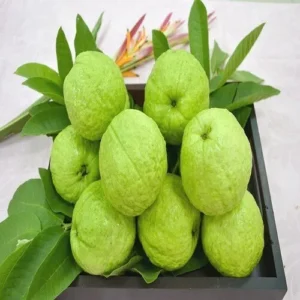
10. Pest and Disease Management:
Pest and disease management is crucial for successful guava cultivation, as pests and diseases can significantly impact fruit production and tree health. Here are some common pests and diseases that affect guava trees, along with general management practices:
Common Pests:
a. Fruit Flies:
Fruit flies lay eggs in ripening fruit, leading to fruit damage and spoilage. To manage fruit flies:
-
- Harvest fruit at the right stage of ripeness.
- Use traps and bait stations to attract and capture adult flies.
- Cover fruits with bags or netting to protect them from infestation.
b. Mealybugs:
Mealybugs feed on plant sap and produce honeydew, leading to sooty mold growth. To manage mealybugs:
-
- Use horticultural oils or insecticidal soaps to suffocate and kill mealybugs.
- Encourage natural enemies like ladybugs and parasitic wasps that prey on mealybugs.
c. Scales:
Scales are small, immobile insects that attach to the tree and feed on sap. To manage scales:
-
- Prune and dispose of heavily infested branches.
- Apply horticultural oils to smother and kill scale insects.
d. Whiteflies:
Whiteflies cause damage by feeding on plant sap and transmitting viruses. To manage whiteflies:
-
- Introduce natural predators like ladybugs, lacewings, and parasitic wasps.
- Use insecticidal soaps or neem oil to control whitefly populations.
Common Diseases:
a. Anthracnose:
Anthracnose is a fungal disease that causes dark lesions on leaves and fruits. To manage anthracnose:
-
- Prune to improve airflow and reduce humidity within the canopy.
- Apply copper-based fungicides during the pre-flowering and post-harvest stages.
b. Fruit Rots:
Various fungal pathogens can cause fruit rot, leading to premature fruit drop. To manage fruit rot:
-
- Harvest fruits at the correct maturity stage and handle them carefully to avoid physical injuries.
- Apply fungicides based on the specific fungal pathogen involved.
Wilt Diseases:
Guava wilt diseases are caused by soil-borne pathogens like Fusarium and Phytophthora species. To manage wilt diseases:
-
- Practice proper irrigation and avoid waterlogged conditions.
- Plant guava on well-drained soil and avoid planting in areas with a history of wilt disease.
Integrated Pest Management (IPM):
-
- Implement an Integrated Pest Management approach that combines cultural, biological, and chemical control methods to manage pests and diseases effectively.
- Regularly monitor the orchard for signs of pests and diseases to take timely action.
Sanitation:
-
- Practice good orchard sanitation by removing fallen leaves, fruits, and pruned branches to reduce disease carryover.
Regular Inspections:
- Conduct regular inspections of the guava trees to identify and address any pest or disease issues promptly.
Resistant Varieties:
-
- Whenever possible, choose guava varieties that are resistant to common pests and diseases prevalent in your region.

11. Harvesting:
-
- Guava fruits are ready for harvest when they attain the desired size and change color. Depending on the variety, this can be when the fruit turns yellow, green, or maroon. Ripe fruits will also emit a pleasant aroma.

12. Post-harvest Handling:
- Handle guava fruits with care to avoid bruising and damage. Store ripe fruits at room temperature and consume them within a few days.
13. Sales And Export of Guava
The sales and export of guava can vary depending on factors such as the country of production, demand in the international market, seasonal availability, and trade agreements. Guava is a popular fruit in tropical and subtropical regions, and its export is driven by its increasing demand, nutritional value, and versatility in various culinary applications. Here’s an overview of the sales and export of guava:
Domestic Sales:
- In countries where guava is grown extensively, such as India, Mexico, Brazil, and Thailand, a significant portion of the guava produced is consumed locally. Domestic sales occur through fresh fruit markets, grocery stores, supermarkets, and fruit vendors.
Regional Trade:
- Guava is traded between neighboring countries and regions with suitable climates for cultivation. For example, guava from Mexico may be exported to the United States, or guava from India may be exported to neighboring countries in South Asia.
International Export:
- Guava is exported to various countries worldwide, primarily to regions where guava is not locally grown or is in demand due to its unique flavor and nutritional value.
- Major guava exporting countries include India, Thailand, Mexico, Pakistan, Brazil, and the Philippines.
- Guava is exported both as fresh fruit and processed products, such as guava pulp, guava juice, dried guava, and guava-based jams and jellies.
Importing Countries:
- Guava is imported by countries with high demand for tropical fruits, especially in regions with limited guava cultivation or during off-seasons.
- Some of the major importing countries include the United States, Canada, European countries, Japan, the Middle East, and parts of Africa.
Challenges:
- Guava’s export faces challenges such as limited shelf life, transportation costs, and compliance with phytosanitary regulations of importing countries.
- To overcome these challenges, some exporting countries invest in post-harvest technologies, cold storage facilities, and improved transportation logistics.
Market Trends:
- The export market for guava is influenced by changing consumer preferences, increasing awareness of the fruit’s health benefits, and the demand for tropical fruits in various culinary industries.
- Processed guava products, such as guava pulp and juice concentrates, have gained popularity in the global market due to their longer shelf life and versatility for use in the food and beverage industry.








